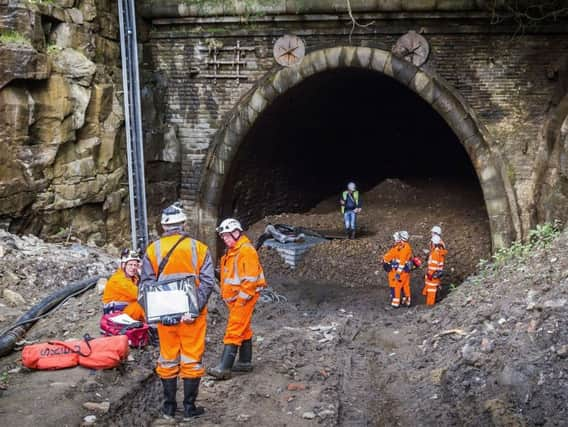Fears over Queensbury tunnel collapse as Highways England start emergency repairs


Tunnel owners, the Department for Transport, are using the powers for work to infill one of the air shafts because of the increasingly deteriorating condition of a section of the structure and fears it could collapse.
The work will be delivered by Highways England who manage the tunnel on the department’s behalf.
Advertisement
Hide AdAdvertisement
Hide AdHighways England Yorkshire and North East Regional Director, Richard Marshall said: “Today’s emergency measures to stabilise one of the air shafts in the tunnel follows an influx of water over the last weekend of September.
"The volume of water entering the tunnel from the southern opening not only endangered the safety of our workforce but also caused the first phase of our safety work to be halted.
“We had been clear that the first phase of the safety work wouldn’t prevent the tunnel’s future reopening. However, the infilling of the shaft in this manner means that any reopening is now going to be more challenging.
“We are aware that this news will be a disappointment to those seeking the reopening of the tunnel, however we have no option other than to complete this work immediately to ensure both the safety of those communities living close by and the workforce who need to maintain it.”
Advertisement
Hide AdAdvertisement
Hide AdQueensbury Tunnel was constructed in the 1870s as part of the railway from Halifax to Keighley, and the line closed in the 1950s.
In 2013 ownership of the Historical Railway Estate (HRE) was transferred to the Secretary of State for Transport from the former British Railways Board (Residuary) Ltd which was abolished that year.
The Highways Agency inherited maintenance responsibility and associated liabilities for the HRE at this time as it was seen as having the necessary expertise. Responsibility for maintaining the HRE then transferred to Highways England in 2015.
For the first time in more than two years contractors took the opportunity to carry out a close inspection of the base of shaft two at the end of last month, at which point water began to enter the tunnel at an unprecedented volume and speed.
Advertisement
Hide AdAdvertisement
Hide AdThey had to abandon equipment and move to a safe area and, within 48 hours, water levels were close to the highest ever recorded.
Engineers determined the affected area, which is close to an access road used by people accessing nearby properties, needed immediate attention.
Water levels in the southern section of the tunnel means further inspections of the base and planned strengthening work can’t be carried out.
The emergency work involves infilling the shaft from above with natural material. This will stabilise the shaft, reducing the risk of collapse.
Advertisement
Hide AdAdvertisement
Hide AdBefore having to stop work, Highways England contractors were close to completing the first phase of safety work, with water levels close to their lowest since October 2018. This was providing partial and short-term strengthening to the most vulnerable sections of the tunnel.
The emergency work is expected to take around two weeks, after which Highways England can determine next steps for resuming the safety work that was halted.